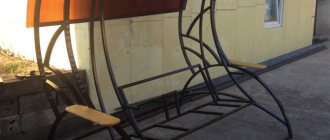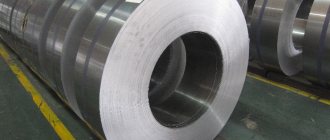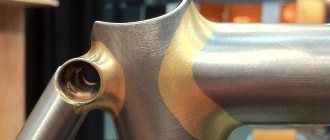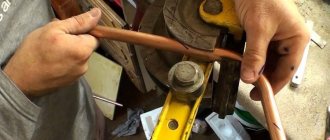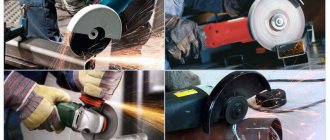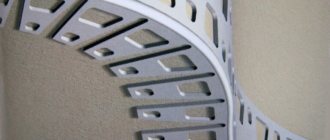MesterulManole
21586 0 3
MesterulManole July 25, 2016Specialization: many years of experience in finishing works of residential and office premises, dachas, country cottages, etc. Hobby: cycling in all its forms
Preheating of the deformable area
Hello dear readers. Today I’ll tell you how to bend a pipe without a pipe bender and with a pipe bender, and how to bend a polypropylene pipe. The topic is of considerable interest since without bent pipes it is difficult to build a greenhouse, gazebo or canopy over the porch.
Selecting a bend method
How to bend a pipe with your own hands? The question is not an easy one. When bending this product yourself, first of all, it is important to take into account the fact that during this process radial and tangential forces arise in the profiled metal, the impact of which can lead to rupture of the section and the appearance of folds on it.
To prevent this from happening, when forming a bend, it is necessary to take into account all the parameters of this process.
The technology that can be applied in each specific case is selected based on:
- Pipe material;
- Its size;
- Required bend angle and radius.
Having made a preliminary assessment of these parameters, you should choose one of the options proposed below. The photos below will help you understand the correct implementation of each of them, demonstrating step by step how to bend a pipe.
Typical mistakes when working
To prevent the plumbing or heating system from malfunctioning, it is recommended not to make mistakes during the bending process. Professionals always work according to a pre-thought-out plan, but if a person is making a pipeline for himself, it would be a good idea to carefully prepare for the creation of the structure.
Typical mistakes when trying to bend a plastic product:
- Try to bend the material using heated air in several places at once: the material can be bent only in the area that is heated with a hair dryer.
- Use a gas burner with a high melting point: in this case, the material will simply melt and deform.
- Bending sewer pipes without following the rules: bending sewer products is not recommended; it is better to purchase a set of fittings and use fasteners to set the angles of the required rotation.
When choosing any method of bending PVC, you should follow all the recommendations so as not to deform the material.
It is important not to press too hard on the pipe when using the cold bending method. To check the permissible angle, you need to multiply the pipe diameter by 8 - this will be the maximum bend radius.
Heat
When exposed to high temperatures, many metals and their alloys become more ductile and less deformable. This rule applies to aluminum, duralumin, steel, copper, brass products and aluminum-ferrous bronze workpieces.
- When heating pipes made of tin bronze, gray cast iron or zinc alloys, you can get the exact opposite effect - they become more brittle when heated.
- It follows from this that not just any pipe can be heated for bending.
- It is possible to heat galvanized pipes, since their coating is not damaged in this case.
- When heating the product, you should not get too carried away, because under the influence of too high temperatures, oxygen begins to penetrate into the material, which entails its oxidation - an irreversible process that destroys the pipe. As an example, we can consider bending an aluminum billet.
- We heat the bending surface and bring a sheet of paper to it. If it lights up, the product can be bent.
As an indicator of the degree of heating of structures made of steel, their reddening to the state of scale can be used.
Popular grades of aluminum for bending
The difficulties of bending both pure aluminum and alloys based on it are associated with the following circumstances:
- During the production process, the metal, in most cases, undergoes artificial or natural aging. In general, it is used to stabilize the structure of the original metal, but for aluminum and its alloys the need for such heat treatment also consists in creating a strong film of the main oxide Al2O3 on the surface. Such a film gives the product the necessary corrosion resistance, but, on the other hand, increases strength and, more importantly, reduces ductility.
- Aluminum pipes are produced using several technologies - rolling, hot extrusion and extrusion. The last two methods are becoming increasingly widespread, however, it is after them that the rolled product is significantly strengthened, and its sensitivity to bending stresses increases.
With any methods of bending profiles, due to the physical characteristics of the process, the location of the so-called “neutral line” is constantly changing - a virtual curve that separates zones with compressive stresses (which are adjacent to the inner surface of the bent workpiece), from zones with tensile stresses located on the outer surface of the bend. Therefore, pipes made of aluminum and its alloys more often crack not along the inner, but along the outer radii.- Tubular profiles not only made of pure aluminum (for example, grades AD0, AD31, AD33, etc.), but also from duralumin type D1 or D16, as well as from aluminum alloys with manganese, have received wide practical application. All these components reduce the ductility of the original workpieces. Since in everyday life the chemical composition of the initial rolled product is often ignored, failures during bending, in particular along a complex spatial contour, are quite possible.
In this regard, before bending aluminum pipes, it is necessary to accurately determine the grade of the alloy and the conditions for its preliminary heat treatment. If there is no certificate for the product, then such a check can be performed in several ways:
- Study the markings, which are usually given on the end sections of the pipe, and then, using available reference books (at least the same “Handbook of Mechanical Designers” by Anuriev, vol. 1), clarify the necessary ductility indicators;
- Lightly tapping the product with a hammer: as the hardness of the material increases, the sound becomes more sonorous;
- The softer alloy sticks to the file (typical, in particular, for AD0 and AMg6), while the harder alloy peels off from its own base;
- All duralumin (and especially D16) initially have low corrosion resistance, therefore they are often sold with a surface coating using the anodizing method. It is permissible to bend such blanks only at small angles;
- Duralumin pipes do not stain your hands upon contact.
Filling with water or sand
Water is poured into the cavity of the workpiece, after which plugs are installed at both ends and cold is placed so that it freezes.
The product is bent by subsequently heating it with a gas burner. This method is not suitable for pipes that have a galvanized coating, as it can lead to damage.
The method using sand is applicable to pipes with a large cross-section or square configuration. Its essence lies in the preliminary filling of the workpiece cavity with sand. Then the pipe is thoroughly heated and bent by tapping it with a mallet. No heat is required to bend galvanized structures.
Properties of plastic pipeline
All plastic pipes can be divided according to the material they are made of: they are made from polymers, polyethylene, polyvinyl chloride. The listed materials have good hygienic characteristics, so they are excellently used for arranging a heating network, as well as for organizing water supply in an apartment.
It’s not always possible to bend the material yourself, so you have to use popular methods
To bend a plastic pipe yourself, you need to learn more about its properties:
- Ring stiffness. The high rigidity of PVC allows it to withstand atmospheric pressure of 120 atmospheres.
- Heat resistance. Plastic is resistant to heat, so it is used for arranging water supply systems with hot and cold water, as well as for organizing heating pipelines. When heated, plastic only expands by 5%.
- Low resistance to frost. Due to their low resistance to frost, the materials cannot withstand temperatures below -15 degrees, and therefore require additional thermal insulation.
- High light transmittance. The PVC pipe, painted in various colors, is UV resistant.
PVC products for pipeline installation are available in various diameters.
When heated, a plastic pipe can be carefully bent because it has good elastic properties. Products made from bendable polyvinyl chloride during production can initially be wound into rings - in this form they go on sale.
Using Templates
This method is suitable for making complex pipe bends. The simplest template can be a piece of wire, pre-bent in accordance with how the product will be bent.
If it is possible to place the bent pipe section on a plane, self-tapping screws twisted into a piece of plywood can act as a kind of template. Bending is done gradually, checking the resulting result with the template from time to time.
List of tools required for bending: recommendations from experts
*
Manufacturers of polypropylene and PVC pipes strongly do not recommend bending the products yourself at home. However, sometimes this procedure is necessary: for this you should stock up on special tools. To work, you will need a hair dryer with good power and the ability to adjust the temperature. You will also need a molding machine if you decide to bend the material using a frame.
A hair dryer must have temperature control
If you don't have a hair dryer, a gas burner may come in handy, but you need to work with it carefully, avoiding melting the pipe. If the element will be bent using wire, you need to prepare wire cutters for cutting it.
It is necessary to heat the product only at the bending point
A few recommendations from professionals will help you cope with the task:
- when using a technical hair dryer, it is necessary to thoroughly heat the upper part of the area where the bend will be made;
- to make identical bends, it is better to prepare a homemade template;
- When using sand, it should be filled until the gap is completely filled, but there is no need to push the bulk substance too much;
- It is better to use metal products for the plug;
- bending should occur slowly, jerking should be avoided.
These methods of bending PVC are the most proven and are often used by craftsmen who do not have a pipe bender. Correct, even turns of the pipeline will prevent the use of fittings, investigator, and the risk of leaks will be minimal.
Application of rolls
This method is suitable for bending a metal profile. It is good because its use reduces friction on the surface of the product and reduces the risk of unwanted deformation.
As a result, much less effort has to be applied to obtain the desired bend, and damage to the part is minimized.
Using rolls, you can make your own pipe bender for bending pipes, allowing you to avoid the use of long parts. The three-roller version is most often used. Two rollers located in it play the role of outer supports, and the third one presses into the center of the fold.
This homemade device allows you to process round pipes, rectangular profiles, as well as plates and corners. Using it, you can bend the same radius over a fairly large length of the workpiece.
How to use a pipe bender at home
Pipe benders are special mechanisms that are characterized by different operating principles. With their help, manual and mechanical bending of profile and round pipes is carried out in production conditions or at home.
There are the following types of manual pipe benders suitable for bending plastic thin-walled aluminum products with a small diameter:
- Lever . This mechanism is also called the Volnov machine. It has a special form for inserting the workpiece. The bending process itself does not require heating the pipe, and is carried out by lever force. The shape corresponds to a specific diameter.
- Crossbow . The structure in which the workpiece is secured is equipped with a bending segment that pushes through the middle of the pipe on the side opposite to the ends.
- Spring-loaded . Before bending, the pipe is equipped with a spring, which is placed inside the product. Next, the workpiece can be heated, or a cold bending method can be used. At the end of the procedure, the spring must be removed.
With the help of machine bending, it is possible to solve the problem of how to bend and how to straighten an aluminum tube of various diameters and shapes. The risk of damage is reduced to almost zero.
These mechanisms can have an electromechanical or hydraulic operating principle, which guarantees an accurate result of the work in accordance with the requirements. There are also ways to bend a pipe without a pipe bender, which is very convenient when you don’t have the necessary tool at hand.
Spring
The essence of this option is to place a spring of the required diameter, made of steel, into a bendable workpiece.
When bending, it holds the pipe, preventing it from being deformed incorrectly. The pre-profile element with a spring inserted into it is heated and then bent using pliers.
In certain cases, the spring can be replaced with a wire. Its bundle is installed in the pipe in separate pieces, and after the bend is completed, it is gradually pulled out.
Profile pipes
Profile pipes can have square, oval and rectangular configurations. It is quite difficult to bend them without violating the technical specifications. The most successful option for carrying out the work would be to use welding with preliminary filing of the walls of the workpiece with a grinder where the bend is planned.
Moreover, it would be advisable to first make cuts and bend the workpiece, and then weld the seams. If the part has a small diameter, then a regular soldering iron will do instead of welding.
Metal-plastic pipes
They bend well by hand without requiring heating. The main thing is to ensure that the workpiece does not become excessively bent.
To perform the bend, you can also use wire by inserting it into the cavity of the metal-plastic pipe being bent, or connect heating to this procedure, while controlling the resulting temperature with a paper sheet.


